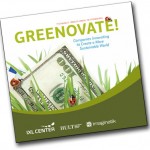Greenovate! BP Energy India and the Smokeless Stove | Source: Innovation Excellence, Dec. 20, 2012
Greenovate! documents 53 case studies that are defined by “sustainable, green innovations” (or “green ovations”). Each profile combines business innovation with a synthesized concept of sustainability, from startups to leading global organizations. The next case study in this special Greenovate! case study series is:
BP ENERGY INDIA – ‘Oorja’ Smokeless Biomass Stove
Target a unique emerging market need with an affordable, clean and safe cooking solution that reduces carbon emissions, with a proven sales model, in India 
INNOVATION
BP Energy’s smokeless biomass stove for rural India uses a rechargeable mini-fan to increase efficiency vs. existing wood stoves. Direct sales model is similar to approaches used in other industries (e.g., microlending with Grameen Bank)
SUSTAINABILITY
By using biomass pellets, the stove’s emissions are greatly reduced, lowering global warming pressures and preserving human health. Provides a promising answer to the rising total emissions in India
RESULTS
Reduces carbon monoxide by 71% and lessens suspended particulate matter by 34% compared to traditional wood-burning stoves. Provides new streams of income for emerging women entrepreneurs in India.
DRIVERS
TACKLE THE ELEPHANT:
India is ranked fourth in the world in creating harmful emissions — traditional wood-burning stoves commonly used in rural areas are responsible for a significant portion of carbon emissions
HEALTH ISSUES:
Indoor air pollution related to wood- burning stoves kills nearly 400,000 people in India each year, according to the World Heath Organization
DEMAND PULL:
Using wood slows the cooking process because of additional tasks such as wood collecting. Existing alternatives like kerosene and liquefied petroleum gas are too expensive and very flammable
BARRIERS
CHANGE OF MINDSET:
The company needed to create a different business model and cater to different customer needs — the Indian market challenged the existing cost structures and price performance of the company
POVERTY:
Economies of scale due to large demand and mass production could lower the price of the stove, but people in rural India may still not be able to afford it because of extreme poverty
DISTRIBUTION:
Targeted customers, the rural poor, could not be reached by the traditional distribution channels
ENABLERS
COMMITTED PARTNERS:
BP Energy India, members of non-governmental organizations, scientists, local entrepreneurs, and end users worked together to design, manufacture, and market the stove
IMPROVING TECHNOLOGY:
Because of efficient material use, the stove costs only about $17; making it affordable for customers of emerging markets — also, a mini-fan blows air to increase combustion efficiency
DIRECT SALES:
Local women, who are trusted by their community, are recruited to sell the stoves — their feedback taught BP about the challenges of rural marketing in a extremely diverse nation
IMPACT
ENVIRONMENT:
The stove reduces carbon monoxide by 71% and lessens suspended particulate matter by 34% compared to traditional wood-burning stoves
CUSTOMERS:
Cooking takes less time because biomass pellets burn more efficiently than wood — annual biomass use would fall from 1.5 – 2 to 0.4 – 0.6 tons per family
SALES FORCE:
The sales of new stoves and the supply of the healthier smokeless fuel pellets provide a sustainable income source for rural women
INTERNAL:
There are hundreds of thousands of stoves in operation at the moment and BP believes it can sell 20 million by 2020
WHAT’S NEXT
Based on the positive experience in India, BP will also test the stove in Vietnam and China.


